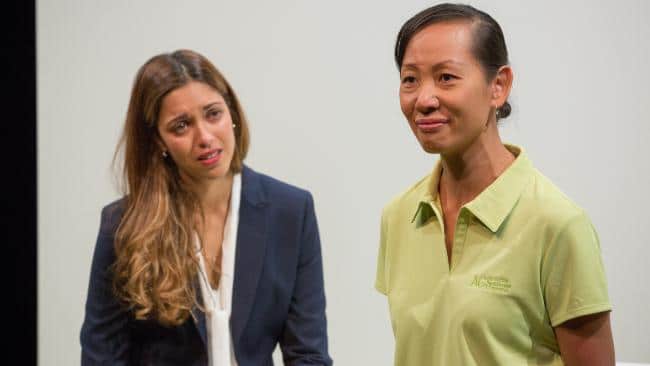At a glance, Rice is a welcomed production filled with the potential to explore emerging forms of power politics and generate progressive representations of race, gender and cultural diversity. The work follows two women of very different circumstances, generations, cultural backgrounds, and economic statuses, both working within the same Australian rice company. There is Nisha (Kristy Best), the CEO of the company whose family migrated from West Bengal two generations back, and Yvette (Hsiao-Ling Tang), a Chinese migrant working as a cleaner while struggling with family and money tribulations. While both of the characters are complex yet believable in their hopes and struggles, the business heavy plot detracts from the desired connection with the two effervescent women.
Overall the play attempts to cover a list of subjects from globalization, to power politics, to cultural diversity, all through the eyes and stories of two unique women. Dissecting all of these elements within a 90-minute show is no easy feat, and while the work manages to combine and compare the two focal females’ relatively dense journeys, all of the business and forceful plot developments take away from much-needed space for a comfortable connection with the characters. The piece’s fast pace and high stakes are undeniable.

Nisha is becoming consistently lightheaded during a huge global business opportunity at the top of the company and Yvette is trying to keep herself afloat while drowning in the disappointment of debt and her daughter’s looming jail sentence. This high tension, however enthralling at first, becomes exhausting, as it is only in the final moments of the play when the business influence is forced to a halt and the characters are left to pick up their emotional pieces. It is Nisha’s story that drives most of this tension-filled, business-driven plot, and Yvette’s heart and humanity is crammed in between. While the high-pressure work environment and business politics are exciting to see, the lack of time given for character reflections keeps the work from truly being able to sing.
The combination of Michele Lee’s snappy writing and Lee Lewis’ fast-paced direction evokes a sense that the work functions like two one-woman shows meshed together. This is initially clever and engaging, but with such a heavily business-driven narrative the characters get mixed up and lost amongst all of the plot’s chaos. The true highlight of the work is Lee’s creativity when exploring how the lives of the two very different women connect and overlap. However, even this overarching achievement is brought down by a repetitive structure technique that darts between the two individual’s lives, the multiple locations they visit, and the various interactions that influence their lives over a few crucial months. Amongst actors quickly changing characters, locations switching within the same office backdrop, and dialogue ending up being breathlessly spat at the audience, moments where the characters are able to slow down and reflect is left few and far between.

Despite the scene change dizziness and plot-heaviness, Tang and Best bring strength, diversity and commitment to the performances of not only their primary roles but also all of the secondary characters that dip in and out of the 90-minute story. While Best rides on a determination to balance her stress with hope and relentless determination, Tang provides a much-needed composure and grounded strength throughout her multiple setbacks.
Further to the actors’ credit, all of the characters’ featured in each of the women’s lives are played by either one of the two actresses, resulting in a consistent presence from both of the women in each other’s lives. Unfortunately, while both actors brought out the struggle, the frustration and the confusion in their leading characters, most of their secondary features in the other’s story felt more like comedic or inconvenient cameos than crucial relationship enhancers.
Just as the heavy plot resulted in the characters’ reflections taking a back seat, it also left little time to properly settle on any one of the many important underlying themes long enough to make a clear point. While topics such as globalization and multiculturalism feature heavily within the characters’ lives, the pressure to take action and speed through decision-making feels closer to a realistic stressful blur than a play conveying an identifiable message. Rather than using two important stories about modern, multicultural women to offer a complex message through the primary themes, the work mixes together a multitude of topics, contexts and characters to simply suggest the problematic nature of the entire setup. Lee provides a complex story but fails to truly share with us the gravity of the issues at hand. With the plot and character development compromised under an evident time crunch, the power of the play’s ability to comment on the critical issues, or offer some kind of hope that sticks, is left diluted at best.

With so much speed and stress within the plot, it is a shame that the design also pushes for repellent features rather than an inviting comfort for the audience amongst all of the chaos. Renee Mulder and Jason Glenwright’s fluorescent lighting and sickly green carpeting fills the wide yet relatively thin stage, creating an urge to fight against an off-putting visual. Thankfully Will Hughes’ compositions and AV design added gentle mood amplification, which was subtle enough to humbly add depth to the work yet clever enough in its cultural influences to add further heart to the piece.
The performers, sound design, and fleeting moments of true insight into the women’s hearts and the themes’ importance were the few redeeming elements in an otherwise tiring and disengaging work. While Rice has an evident potential to provide insightful observations about its characters and their under-acknowledged circumstances, it’s a shame that the work didn’t use its time more wisely.
Photo: Stephen Henry



